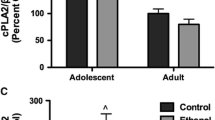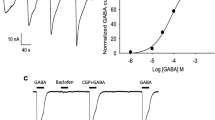Abstract
One of the biochemical results of ethanol exposure is a change in the amount of the intracellular second messenger cyclic AMP (cAMP) produced in response to receptor stimulation1–11. In general, acute ethanol exposure increases the amount of cAMP produced on stimulation of receptors coupled to the enzyme adenylyl cyclase via the GTP-binding protein Gs1,4–8,104"8'10, whereas chronic ethanol exposure has the opposite effect1,2,7,9,10 (results for receptors coupled via Gi have been more variable). We previously reported that adaptation to continuous ethanol exposure reduces receptor-stimulated cAMP production by 25–35% in a neuroblas-toma cell line (NG108-15)1, and an even greater reduction of 75% was observed in lymphocytes taken from actively-drinking alcoholics2. This reduction in receptor-stimulated cAMP levels was recently confirmed in platelets from alcoholics12. Nope of these studies, however, determined whether more than one receptor coupled to adenylyl cyclase activity was affected in the same cell. Here we report that chronic ethanol exposure causes desensitization of heterologous receptors coupled to Gs as cAMP production mediated by prostaglandin E1 as well as by adenosine is reduced by ∼30% in NG108-15 cells. We show that, after chronic ethanol exposure, the activity of the α subunit of Gs is decreased by 29%, the amount of αs protein is decreased by 38.5%, and αs messenger RNA is decreased by 30%. Thus, cellular adaptation to ethanol involves a reduction in αs mRNA and, as a consequence, reduced cAMP production by heterologous receptors coupled to Gs. Such changes in cAMP production may account for the tolerance and physical dependence on ethanol in alcoholism.
Similar content being viewed by others
References
Gordon, A. S., Collier, K. & Diamond, I. Proc. natn. Acad. Sci. U.S.A. 83, 2105–2108 (1986).
Diamond, I., Wrubel, B., Estrin, W. & Gordon, A. Proc. natn. Acad. Sci. U.S.A. 84, 1413–1416 (1987).
Volicer, L., Mirin, R. & Gold, B. I. J. Stud. Alcohol 38, 11–24 (1977).
Hynie, S., Lanefelt, F. & Fredholm, B. B. Acta pharmac. tox. 47, 58–65 (1980).
Rabin, R. A. & Molinoff, P. B. J. Pharmac. exp. Ther. 227, 551–556 (1983).
Luthin, G. R. & Tabakoff, B. J. Pharmac. exp. Ther. 228, 579–587 (1984).
Richelson, E., Stenstrom, S., Forray, C., Enloe, L. & Pfenning, M. J. Pharmac. exp. Ther. 239, 687–692 (1986).
Saito, T., Lee, J. M. & Tabakoff, B. J. Neurochem. 44, 1037–1044 (1985).
Charness, M. E., Querimit, L. A. & Diamond, I. J. biol. Chem. 261, 3164–3169 (1986).
Bauche, F., Bourdeaux-Jaubert, M., Guidicelli, Y. & Nordmann, R. FEBS Lett. 219, 296–300 (1987).
Dave, J. R., Eiden, L. E., Karanian, J. W. & Eskay, R. L. Endocrinology 118, 280–286 (1986).
Tabakoff, B. et al. N. Engl. J. Med. 318, 134–139 (1988).
Sharma, S. K., Klee, W. A. & Nirenberg, M. Proc. natn. Acad. Sci. U.S.A. 72, 3092–3096 (1975).
Stryer, L. & Bourne, H. R. A. Rev. Cell Biol. 2, 391–419 (1986).
Birnbaumer, L. et al. in Molecular Mechanisms of Transmembrane Signalling (eds Cohen, P. & Houslay, M. D.) 131–182 (Elsevier, New York, 1985).
Farfel, Z., Brickman, A. S., Kaslow, H. R., Brothers, V. M. & Bourne, H. R. N. Engl. J. Med. 303, 237–242 (1980).
Chang, F.-H. & Bourne, H. R. Endocrinology 121, 1711–1715 (1987).
Southern, E. M. J. molec. Biol. 98, 503–517 (1975).
Parent, L. J., Ehrlich, R., Matis, L. & Singer, D. S. FASEB J. 1, 469–473 (1987).
Koch, T. K., Gordon, A. S. & Diamond, I. Biochem. Biophys. Res. Commun. 114, 339–347 (1983).
Mumby, S. M., Kahn, R. A., Manning, D. R. & Gilman, A. G. Proc. natn. Acad. Sci. U.S.A. 83, 265–269 (1986).
Cathala, G. et al. DNA 2, 329–335 (1983).
Thomas, P. S. Proc. natn. Acad. Sci. U.S.A. 77, 5201–5205 (1980).
Feinberg, A. P. & Vogelstein, B. Analyt. Biochem. 132, 6–13 (1983).
Author information
Authors and Affiliations
Rights and permissions
About this article
Cite this article
Mochly-Rosen, D., Chang, FH., Cheever, L. et al. Chronic ethanol causes heterologous desensitization of receptors by reducing αsmessenger RNA. Nature 333, 848–850 (1988). https://doi.org/10.1038/333848a0
Received:
Accepted:
Issue Date:
DOI: https://doi.org/10.1038/333848a0
- Springer Nature Limited
This article is cited by
-
Neuroscience of alcoholism: molecular and cellular mechanisms
Cellular and Molecular Life Sciences (2010)
-
Regulation of cellular signals by G-proteins
Journal of Biosciences (1997)
-
Evidence for prolonged recovery of dopaminergic transmission after detoxification in alcoholics with poor treatment outcome
Journal of Neural Transmission (1995)





